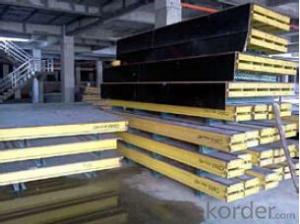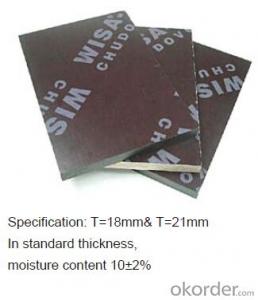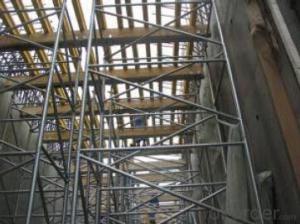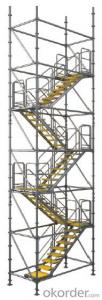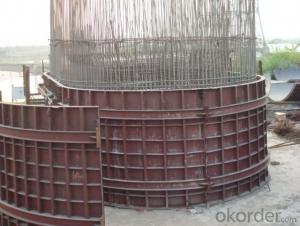Plywood Formwork systems for Formwork and Scaffolding
- Loading Port:
- Tianjin
- Payment Terms:
- TT OR LC
- Min Order Qty:
- 50 m²
- Supply Capability:
- 1000 m²/month
OKorder Service Pledge
Quality Product, Order Online Tracking, Timely Delivery
OKorder Financial Service
Credit Rating, Credit Services, Credit Purchasing
You Might Also Like
Plywood --- make perfect concrete surface
WISA-Form Birch is a coated special plywood using in the formwork systems where high
requirements are set on the concrete surface and the times of reuses.
With CNBM timber beam & WISA plywood, the formwork is low weight but high load capacity, it is
widely used in construction.
Characteristics:
◆ Component with high standardization.
◆ Assembling in site, flexible application.
◆ Light weight, easy transportation and storage.
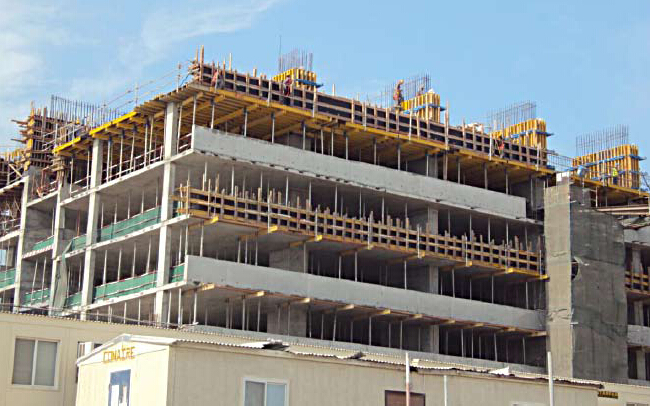
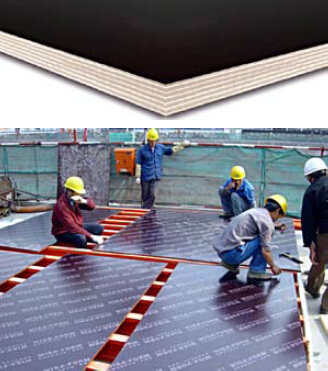
- Q: How does steel formwork contribute to the safety of construction workers?
- Steel formwork contributes to the safety of construction workers in several ways. Firstly, steel formwork is known for its durability and strength, which provides a stable and secure working platform for construction workers. This stability minimizes the risk of accidents or injuries caused by unstable or collapsing structures. Additionally, steel formwork is designed to be fire-resistant, offering an added layer of protection in case of fire hazards on construction sites. This not only safeguards the workers but also helps to prevent the spread of fire to neighboring structures. Furthermore, steel formwork is often prefabricated and can be easily assembled and disassembled, reducing the time workers spend on-site and minimizing their exposure to potential hazards. The ease of assembly also ensures that the formwork is properly installed, eliminating the risk of weak or faulty structures that could pose a threat to workers. Moreover, steel formwork is designed with safety features such as handrails, guardrails, and non-slip surfaces. These features provide additional protection to workers, preventing falls and accidents while working at heights or on elevated platforms. Lastly, steel formwork is designed to withstand external forces such as wind, earthquakes, or heavy loads, making it more resistant to structural failures. This resilience reduces the risk of accidents and injuries caused by structural collapses, providing a safer working environment for construction workers. In summary, steel formwork contributes significantly to the safety of construction workers by offering stability, fire resistance, ease of assembly, safety features, and resilience to external forces. These features ensure that workers can carry out their tasks in a secure environment, minimizing the risks associated with construction activities.
- Q: How does steel formwork handle concrete shrinkage and cracking?
- Steel formwork is a versatile and durable option when it comes to dealing with concrete shrinkage and cracking. Its design ensures support and stability during the pouring and curing process, effectively minimizing the negative effects of shrinkage and cracking. One of the main benefits of steel formwork is its capacity to withstand the pressure exerted by shrinking concrete. Steel is a resilient material that can resist the forces generated by the drying and hardening of the concrete. As a result, the formwork remains intact and does not deform or collapse under the weight of the shrinking concrete. Moreover, steel formwork often incorporates expansion joints or other flexible components that can accommodate the movement caused by shrinkage and cracking. These joints allow the formwork to expand and contract in sync with the concrete, reducing stress on the structure and minimizing the risk of cracks. Additionally, steel formwork can be easily reinforced or supplemented with additional support elements, like braces or tie rods, to further enhance its ability to handle concrete shrinkage and cracking. These reinforcements ensure the forces exerted by the shrinking concrete are evenly distributed across the formwork, decreasing the likelihood of localized cracking or structural failure. In summary, steel formwork is a reliable and robust solution for effectively managing concrete shrinkage and cracking. Its strength, flexibility, and capacity for reinforcement make it an ideal choice for construction projects where minimizing the impact of these issues is of utmost importance.
- Q: Can steel formwork be used in healthcare or medical facility construction projects?
- Indeed, healthcare or medical facility construction projects can utilize steel formwork. Steel formwork is a flexible and long-lasting solution that is often favored in construction endeavors due to its robustness, stability, and ability to be reused. When it comes to healthcare or medical facility construction, steel formwork offers numerous benefits. First and foremost, steel formwork provides exceptional structural integrity, which is crucial in healthcare facilities where safety and stability are of utmost importance. It can endure heavy loads and serve as a solid foundation for concrete walls, columns, and slabs. This is particularly vital in areas like operating rooms or intensive care units where precision and stability are crucial. Secondly, steel formwork is highly adaptable and can be easily tailored to meet specific design requirements. Healthcare facilities often have unique layouts and intricate architectural features, and steel formwork can be fabricated to accommodate these complexities. Whether it involves shaping curved walls, circular columns, or irregular forms, steel formwork offers the necessary flexibility to bring the design vision to life. Furthermore, steel formwork is renowned for its reusability. In healthcare projects where time and cost efficiency are paramount, reusing formwork can significantly reduce construction time and expenses. Steel formwork can be swiftly disassembled, cleaned, and reassembled for future projects, making it an environmentally friendly and cost-effective choice. Lastly, steel formwork exhibits exceptional resistance to fire, moisture, and adverse weather conditions. In healthcare facilities, where cleanliness and infection control are critical, the non-porous surface of steel formwork can be easily cleaned and maintained. Additionally, it provides excellent fire protection, ensuring the safety of patients and staff. In conclusion, steel formwork is undeniably suitable for healthcare or medical facility construction projects. Its strength, adaptability, reusability, and durability make it an ideal choice for creating secure and functional spaces in healthcare facilities.
- Q: How is steel formwork used in construction projects?
- The technique of steel formwork is widely employed in construction, using steel panels and frames to create temporary molds or formworks. These formworks are utilized to shape and provide support for wet concrete until it sets and solidifies into the desired structure. When it comes to construction projects, steel formwork is mainly utilized for large-scale endeavors like high-rise buildings, bridges, and dams. The use of steel formwork offers several advantages over traditional timber formwork, including enhanced strength, durability, and the ability to be reused. To utilize steel formwork, the initial step involves designing and fabricating the steel panels and frames based on the specific project requirements. These panels are typically made from high-quality steel, ensuring they are strong enough to withstand the weight and pressure of wet concrete. Once the steel formwork is fabricated, it is transported to the construction site and assembled by skilled workers. The panels are connected together using various methods such as clamps or bolts, creating a sturdy framework. This framework serves as a mold, providing support and containment for the wet concrete. The steel formwork is then meticulously positioned and aligned according to the project plans. Reinforcement bars, also known as rebars, are often placed within the formwork to add strength to the final structure. Once everything is in place, the concrete is poured into the formwork, filling the designated areas. During the curing process, the steel formwork plays a vital role in ensuring the concrete maintains its shape and strength. The steel panels prevent the concrete from bulging or deforming under its own weight, resulting in a finished product that is of high quality and structurally sound. After the concrete has hardened and gained enough strength, the steel formwork can be removed. Due to its durability and ability to be reused, the steel formwork can be disassembled and utilized in multiple construction projects, making it a practical and sustainable option. In conclusion, steel formwork is a crucial element in construction projects, offering a reliable and efficient method for shaping and supporting wet concrete. Its strength, durability, and reusability make it a popular choice for large-scale projects, ensuring the successful completion of various structures.
- Q: How does steel formwork contribute to the overall sustainability of a construction project?
- Steel formwork contributes to the overall sustainability of a construction project in several ways. Firstly, steel formwork is reusable, which reduces the consumption of raw materials and reduces waste generation. This not only lowers the project's environmental impact but also saves costs in the long run. Secondly, steel formwork provides a durable and robust solution, ensuring a longer lifespan and reducing the need for frequent replacements. Additionally, steel formwork is highly versatile and can be easily adjusted and modified to accommodate various design changes, reducing the amount of material waste. Lastly, steel formwork allows for efficient and faster construction, reducing the project's energy consumption and minimizing disruption to the surrounding environment.
- Q: What are the different types of formwork anchors used in steel formwork?
- There are several types of formwork anchors commonly used in steel formwork, including wedge anchors, sleeve anchors, and through-bolt anchors. Wedge anchors are inserted into pre-drilled holes in the steel formwork and are tightened with a wrench to secure the formwork in place. Sleeve anchors are similar to wedge anchors but have a sleeve that expands against the sides of the hole to provide additional stability. Through-bolt anchors consist of a threaded rod that passes through the formwork and is secured with a nut on the opposite side. These anchors offer a strong and reliable connection for steel formwork.
- Q: Can steel formwork be used for architectural concrete walls?
- Yes, steel formwork can be used for architectural concrete walls. Steel formwork provides a strong and durable framework that can withstand the pressure of wet concrete and result in smooth and precise finishes. It is commonly used for complex shapes and designs in architectural concrete walls as it allows for flexibility and ease of construction.
- Q: How does steel formwork handle different concrete curing time requirements?
- Steel formwork is a versatile and durable option for construction projects, including concrete structures. When it comes to handling different concrete curing time requirements, steel formwork offers several advantages. Firstly, steel formwork provides a robust and stable framework for the concrete to be poured into. This ensures that the concrete is held in place and maintains its desired shape during the curing process. Regardless of the required curing time, steel formwork can effectively support the weight and pressure exerted by the concrete, preventing any deformation or collapse. Moreover, steel formwork is highly adjustable and customizable. It can be easily modified to accommodate different curing time requirements. For instance, if a particular section of concrete requires a longer curing time, additional support can be added to the steel formwork to provide extra strength and stability. On the other hand, if a section requires a shorter curing time, the steel formwork can be adjusted accordingly to facilitate quicker curing. Additionally, steel formwork has excellent heat conductivity properties. This allows for efficient heat dissipation during the concrete curing process. Different concrete mixes may have varying heat generation rates during hydration, and steel formwork aids in maintaining uniform curing temperatures. This is particularly beneficial when dealing with concrete structures that have specific curing temperature requirements. Furthermore, steel formwork is reusable and can withstand multiple casting cycles. This means that it can be used for different projects with varying concrete curing time requirements, making it a cost-effective option. The durability and strength of steel formwork ensure its longevity, enabling contractors to adapt to different curing time requirements without the need for constant replacement. In conclusion, steel formwork is well-suited to handle different concrete curing time requirements. Its stability, adjustability, heat conductivity, and reusability make it an ideal choice for construction projects of various scales and complexities. Whether the concrete requires a longer or shorter curing time, steel formwork provides the necessary support and flexibility to ensure successful curing and the creation of strong and durable concrete structures.
- Q: Can steel formwork be used in areas with limited construction equipment access?
- Indeed, areas with limited access to construction equipment can still utilize steel formwork. Renowned for its durability and strength, steel formwork proves ideal for remote or challenging locales. Differing from other formwork types, steel formwork does not necessitate extensive machinery or equipment during installation. Instead, it can be conveniently transported and manually assembled, diminishing the reliance on heavy machinery. Furthermore, steel formwork is reusable, allowing for disassembly and relocation to different sites, if needed. Such adaptability renders steel formwork a pragmatic option for construction endeavors in equipment-constrained areas, guaranteeing efficient and cost-effective construction procedures.
- Q: What are the characteristics of steel formwork
- 5, good insulation performance, is conducive to the preservation of concrete in winter.6, easy maintenance, can be repaired in the local damage surface, when one side wear, you can flip the use of the plate.
Send your message to us
Plywood Formwork systems for Formwork and Scaffolding
- Loading Port:
- Tianjin
- Payment Terms:
- TT OR LC
- Min Order Qty:
- 50 m²
- Supply Capability:
- 1000 m²/month
OKorder Service Pledge
Quality Product, Order Online Tracking, Timely Delivery
OKorder Financial Service
Credit Rating, Credit Services, Credit Purchasing
Similar products
Hot products
Hot Searches
Related keywords
